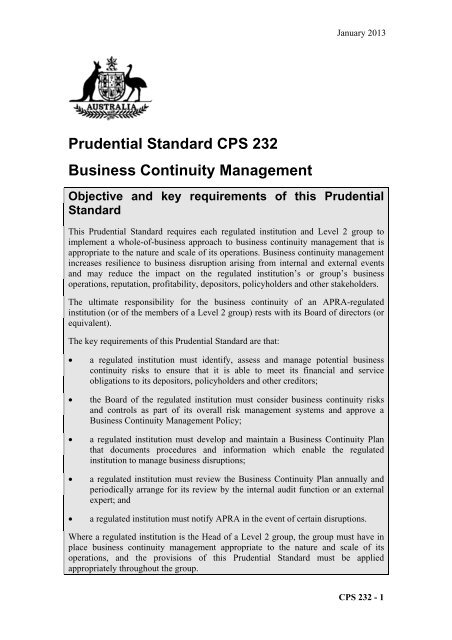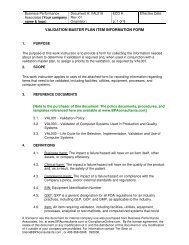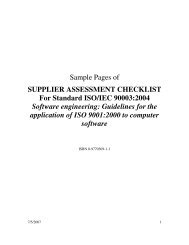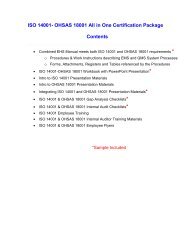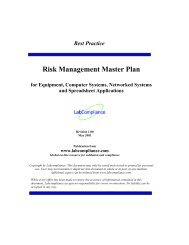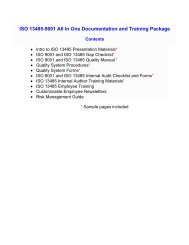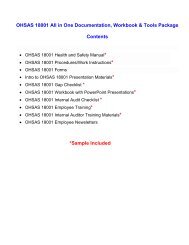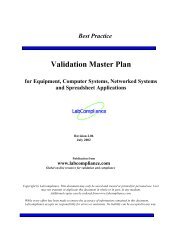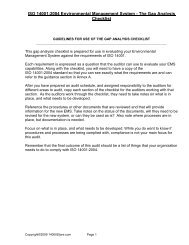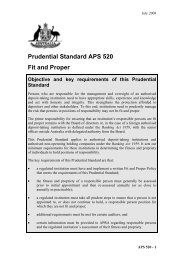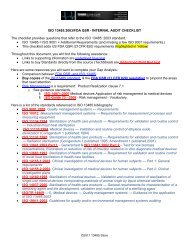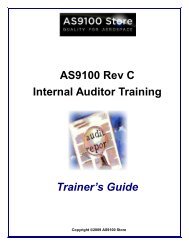Prudential Standard CPS 232 Business Continuity Management
CPS 232 Business Continuity Management - Australian Prudential ...
CPS 232 Business Continuity Management - Australian Prudential ...
- No tags were found...
You also want an ePaper? Increase the reach of your titles
YUMPU automatically turns print PDFs into web optimized ePapers that Google loves.
January 2013<br />
<strong>Prudential</strong> <strong>Standard</strong> <strong>CPS</strong> <strong>232</strong><br />
<strong>Business</strong> <strong>Continuity</strong> <strong>Management</strong><br />
Objective and key requirements of this <strong>Prudential</strong><br />
<strong>Standard</strong><br />
This <strong>Prudential</strong> <strong>Standard</strong> requires each regulated institution and Level 2 group to<br />
implement a whole-of-business approach to business continuity management that is<br />
appropriate to the nature and scale of its operations. <strong>Business</strong> continuity management<br />
increases resilience to business disruption arising from internal and external events<br />
and may reduce the impact on the regulated institution’s or group’s business<br />
operations, reputation, profitability, depositors, policyholders and other stakeholders.<br />
The ultimate responsibility for the business continuity of an APRA-regulated<br />
institution (or of the members of a Level 2 group) rests with its Board of directors (or<br />
equivalent).<br />
The key requirements of this <strong>Prudential</strong> <strong>Standard</strong> are that:<br />
• a regulated institution must identify, assess and manage potential business<br />
continuity risks to ensure that it is able to meet its financial and service<br />
obligations to its depositors, policyholders and other creditors;<br />
• the Board of the regulated institution must consider business continuity risks<br />
and controls as part of its overall risk management systems and approve a<br />
<strong>Business</strong> <strong>Continuity</strong> <strong>Management</strong> Policy;<br />
• a regulated institution must develop and maintain a <strong>Business</strong> <strong>Continuity</strong> Plan<br />
that documents procedures and information which enable the regulated<br />
institution to manage business disruptions;<br />
• a regulated institution must review the <strong>Business</strong> <strong>Continuity</strong> Plan annually and<br />
periodically arrange for its review by the internal audit function or an external<br />
expert; and<br />
• a regulated institution must notify APRA in the event of certain disruptions.<br />
Where a regulated institution is the Head of a Level 2 group, the group must have in<br />
place business continuity management appropriate to the nature and scale of its<br />
operations, and the provisions of this <strong>Prudential</strong> <strong>Standard</strong> must be applied<br />
appropriately throughout the group.<br />
<strong>CPS</strong> <strong>232</strong> - 1
January 2013<br />
Authority<br />
1. This <strong>Prudential</strong> <strong>Standard</strong> is made under:<br />
(a)<br />
(b)<br />
(c)<br />
section 11AF of the Banking Act 1959 (Banking Act) in relation to<br />
authorised deposit-taking institutions (ADIs) and non-operating<br />
holding companies authorised under the Banking Act (authorised<br />
banking NOHCs);<br />
section 32 of the Insurance Act 1973 (Insurance Act) in relation to<br />
general insurers and non-operating holding companies authorised<br />
under the Insurance Act (authorised insurance NOHCs) and parent<br />
entities of Level 2 insurance groups; and<br />
section 230A of the Life Insurance Act 1995 (Life Insurance Act) in<br />
relation to life companies, including friendly societies, and<br />
non-operating holding companies registered under the Life Insurance<br />
Act (registered life NOHCs).<br />
Application<br />
2. This <strong>Prudential</strong> <strong>Standard</strong> applies to:<br />
(a)<br />
(b)<br />
(c)<br />
all ADIs, including foreign ADIs, and authorised banking NOHCs;<br />
all general insurers, including Category C insurers, authorised insurance<br />
NOHCs and parent entities of Level 2 insurance groups; and<br />
all life companies, including friendly societies and eligible foreign life<br />
insurance companies (EFLICs), and registered life NOHCs.<br />
These institutions are collectively referred to as ‘regulated institutions’ in this<br />
<strong>Prudential</strong> <strong>Standard</strong>.<br />
3. A requirement imposed upon a regulated institution that is also Head of a Level<br />
2 group 1 is to be read as requiring that regulated institution to ensure that the<br />
applicable provision is applied appropriately throughout the Level 2 group. 2<br />
4. All regulated institutions have to comply with this <strong>Prudential</strong> <strong>Standard</strong> in its<br />
entirety, unless otherwise expressly indicated. The obligations imposed by this<br />
<strong>Prudential</strong> <strong>Standard</strong> on, or in relation to, a foreign ADI, a Category C insurer or<br />
an EFLIC apply only in relation to the Australian business of that institution.<br />
1<br />
2<br />
Paragraph 10 defines Head of a Level 2 group.<br />
Paragraph 9 defines Level 2 group.<br />
<strong>CPS</strong> <strong>232</strong> - 2
January 2013<br />
5. This <strong>Prudential</strong> <strong>Standard</strong> applies whether or not activities are outsourced to<br />
related bodies corporate or third-party service providers. This <strong>Prudential</strong><br />
<strong>Standard</strong> also applies to arrangements where the service provider is located<br />
outside Australia or the functions are performed outside Australia.<br />
6. Nothing in this <strong>Prudential</strong> <strong>Standard</strong> prevents a regulated institution from<br />
adopting and applying a group policy used by a related body corporate 3 ,<br />
provided that the policy has been approved by the Board 4 of the regulated<br />
institution and meets the requirements of this <strong>Prudential</strong> <strong>Standard</strong>.<br />
7. This <strong>Prudential</strong> <strong>Standard</strong> commences on 1 January 2013.<br />
Interpretation<br />
8. Terms that are defined in <strong>Prudential</strong> <strong>Standard</strong> APS 001 Definitions (APS 001),<br />
<strong>Prudential</strong> <strong>Standard</strong> GPS 001 Definitions (GPS 001) or <strong>Prudential</strong> <strong>Standard</strong><br />
LPS 001 Definitions (LPS 001) appear in bold the first time they are used in this<br />
<strong>Prudential</strong> <strong>Standard</strong>.<br />
9. A ‘Level 2 group’ is:<br />
(a)<br />
the consolidation of entities defined as Level 2 in APS 001; or<br />
(b) a Level 2 insurance group as defined in GPS 001.<br />
10. The ‘Head of a Level 2 group’ is:<br />
(a)<br />
(b)<br />
where an ADI that is a member of a Level 2 group is not a subsidiary of<br />
an authorised banking NOHC or another ADI, that ADI;<br />
where an ADI that is a member of a Level 2 group is a subsidiary of an<br />
authorised banking NOHC, that authorised banking NOHC; or<br />
(c) the parent entity of a Level 2 insurance group as defined in GPS 001.<br />
The role of the Board and senior management<br />
11. A regulated institution must identify, assess, manage, mitigate and report on<br />
potential business continuity risks to ensure that it is able to meet its financial<br />
and service obligations to its depositors, policyholders and other creditors.<br />
12. The Board is ultimately responsible for the business continuity of the regulated<br />
institution. The Board remains responsible for business continuity management<br />
(BCM) whether or not business operations are outsourced or are part of a<br />
corporate group. 5<br />
3<br />
4<br />
5<br />
Related body corporate has the meaning given in section 50 of the Corporations Act 2001.<br />
A reference to the Board, in the case of a foreign ADI, Category C insurer or an EFLIC, is a<br />
reference to the senior officer outside Australia or Compliance Committee (as applicable) as<br />
referred to in <strong>Prudential</strong> <strong>Standard</strong> <strong>CPS</strong> 510 Governance.<br />
Refer to <strong>Prudential</strong> <strong>Standard</strong> <strong>CPS</strong> 231 Outsourcing (<strong>CPS</strong> 231) for further information on<br />
requirements relating to outsourcing.<br />
<strong>CPS</strong> <strong>232</strong> - 3
January 2013<br />
13. The Board may delegate day–to-day operational responsibility for BCM to a<br />
responsible committee, including a responsible committee of the Head of the<br />
Level 2 group, and/or senior management. The operational responsibility must<br />
be clearly expressed in the charter of the committee and/or in the performance<br />
objective of the responsible senior management.<br />
14. The Board must approve the regulated institution’s <strong>Business</strong> <strong>Continuity</strong><br />
<strong>Management</strong> Policy (BCM Policy) (refer to paragraphs 20 and 21).<br />
15. The Board must ensure that the regulated institution’s business continuity risks<br />
and controls are taken into account as part of its overall risk management<br />
systems and when completing a risk management declaration required to be<br />
provided to APRA. 6<br />
<strong>Business</strong> continuity management<br />
16. BCM is a whole-of-business approach that includes policies, standards and<br />
procedures for ensuring that critical business operations can be maintained or<br />
recovered in a timely fashion, in the event of a disruption. Its purpose is to<br />
minimise the financial, legal, regulatory, reputational and other material<br />
consequences arising from a disruption.<br />
17. Critical business operations are the business functions, resources and<br />
infrastructure that may, if disrupted, have a material impact on the regulated<br />
institution’s business functions, reputation, profitability, depositors and/or<br />
policyholders.<br />
18. A regulated institution’s BCM must, at a minimum, include:<br />
(a) a BCM Policy in accordance with paragraphs 20 and 21;<br />
(b)<br />
(c)<br />
(d)<br />
(e)<br />
a business impact analysis (BIA) including risk assessment in accordance<br />
with paragraphs 22 and 23;<br />
recovery objectives and strategies; in accordance with paragraphs 24 and<br />
25;<br />
a business continuity plan (BCP) including crisis management and<br />
recovery in accordance with paragraphs 26 to 28; and<br />
programs for:<br />
(i)<br />
(ii)<br />
review and testing of the BCP in accordance with paragraph 29; and<br />
training and ensuring awareness of staff in relation to BCM.<br />
19. In addition to the requirements stated elsewhere in this <strong>Prudential</strong> <strong>Standard</strong>, the<br />
Board of the Head of a Level 2 group must:<br />
6<br />
Refer to <strong>Prudential</strong> <strong>Standard</strong> APS 310 Audit and Related Matters (APS 310), <strong>Prudential</strong><br />
<strong>Standard</strong> GPS 220 Risk <strong>Management</strong> and <strong>Prudential</strong> <strong>Standard</strong> LPS 220 Risk <strong>Management</strong>.<br />
<strong>CPS</strong> <strong>232</strong> - 4
January 2013<br />
(a)<br />
(b)<br />
(c)<br />
(d)<br />
ensure that the Level 2 group’s BCM is appropriate to the nature and scale<br />
of its operations and is consistent with the Level 2 group’s risk<br />
management strategy or framework;<br />
consistently apply BCM for each part of the Level 2 group;<br />
apply BCM to risk assessments and risk processes at a functional level in<br />
the Level 2 group, where appropriate; and<br />
ensure that the Level 2 group’s BCP is reviewed at least annually by<br />
responsible senior management of the Head of the Level 2 group.<br />
BCM Policy<br />
20. A regulated institution must have an up-to-date documented BCM Policy that<br />
sets out its objectives and approach in relation to BCM.<br />
21. The BCM Policy must clearly state the roles, responsibilities and authorities to<br />
act in relation to the BCM Policy.<br />
<strong>Business</strong> impact analysis<br />
22. A BIA involves identifying all critical business functions, resources and<br />
infrastructure of the regulated institution and assessing the impact of a<br />
disruption on these.<br />
23. When conducting the BIA, the regulated institution must consider:<br />
(a)<br />
(b)<br />
(c)<br />
(d)<br />
plausible disruption scenarios over varying periods of time;<br />
the period of time for which the regulated institution could not operate<br />
without each of its critical business operations;<br />
the extent to which a disruption to the critical business operations might<br />
have a material impact on the interests of depositors and/or policyholders<br />
of the regulated institution; and<br />
the financial, legal, regulatory and reputational impact of a disruption to a<br />
regulated institution’s critical business operations over varying periods of<br />
time.<br />
Recovery objectives and strategies<br />
24. Recovery objectives are pre-defined goals for recovering critical business<br />
operations to a specified level of service (recovery level) within a defined period<br />
(recovery time) following a disruption.<br />
25. A regulated institution must identify and document appropriate recovery<br />
objectives and implementation strategies based on the results of the BIA and the<br />
size and complexity of the regulated institution.<br />
<strong>CPS</strong> <strong>232</strong> - 5
January 2013<br />
<strong>Business</strong> continuity planning<br />
26. A regulated institution must maintain at all times a documented BCP that meets<br />
the objectives of the BCM Policy. 7<br />
27. The BCP must document procedures and information that enable the regulated<br />
institution to:<br />
(a)<br />
(b)<br />
manage an initial business disruption (crisis management); and<br />
recover critical business operations.<br />
28. The BCP must reflect the specific requirements of the regulated institution and<br />
must identify:<br />
(a)<br />
(b)<br />
(c)<br />
(d)<br />
(e)<br />
(f)<br />
critical business operations;<br />
recovery levels and time targets for each critical business operation;<br />
recovery strategies for each critical business operation;<br />
infrastructure and resources required to implement the BCP;<br />
roles, responsibilities and authorities to act in relation to the BCP; and<br />
communication plans with staff and external stakeholders.<br />
Review and testing of the BCP<br />
29. A regulated institution must review and test its BCP at least annually, or more<br />
frequently if there are material changes to business operations, to ensure that the<br />
BCP can meet the BCM objectives. The results of the testing must be formally<br />
reported to the Board or to delegated management. 8<br />
30. The BCP must be updated if shortcomings are identified as a result of the<br />
review and testing required under paragraph 29.<br />
Notification requirements<br />
31. A regulated institution must notify APRA as soon as possible and no later than<br />
24 hours after experiencing a major disruption that has the potential to have a<br />
material impact on the regulated institution’s risk profile, or affect its financial<br />
soundness. The regulated institution must explain to APRA the nature of the<br />
disruption, the action being taken, the likely effect and the timeframe for<br />
returning to normal operations. The regulated institution must notify APRA<br />
when normal operations resume.<br />
7<br />
8<br />
A reference to a BCP may be a reference to an individual BCP or to a collection of them. An<br />
APRA-regulated entity may have a number of BCPs. A BCP may include a separate crisis<br />
management plan and disaster recovery plan.<br />
A material change to business operations includes a change in a material outsourcing<br />
arrangement. Refer to <strong>CPS</strong> 231 for further information on outsourcing.<br />
<strong>CPS</strong> <strong>232</strong> - 6
January 2013<br />
32. The information or notifications required by this <strong>Prudential</strong> <strong>Standard</strong> must be<br />
given in such form, if any, and by such procedures, if any, as APRA determines<br />
and publishes on its website from time to time.<br />
Audit arrangements<br />
33. A regulated institution’s internal audit function, or an external expert, must<br />
periodically review the BCP and provide an assurance to the Board or to<br />
delegated management that:<br />
(a)<br />
(b)<br />
the BCP is in accordance with the regulated institution’s BCM Policy and<br />
addresses the risks it is designed to control; and<br />
testing procedures are adequate and have been conducted satisfactorily.<br />
34. APRA may request the external auditor of the regulated institution, or another<br />
appropriate external expert, to provide an assessment of the regulated<br />
institution’s BCM arrangements. Any such report must be paid for by the<br />
regulated institution and must be made available to APRA. 9<br />
Adjustments and exclusions<br />
35. APRA may, by notice in writing to a regulated institution, adjust or exclude a<br />
specific prudential requirement in this <strong>Prudential</strong> <strong>Standard</strong> in relation to that<br />
regulated institution. 10<br />
Determinations made under previous prudential standards<br />
36. An exercise of APRA’s discretion (such as an approval, waiver or direction)<br />
under a previous version of this <strong>Prudential</strong> <strong>Standard</strong> continues to have effect as<br />
though exercised pursuant to a corresponding power (if any) exercisable by<br />
APRA under this <strong>Prudential</strong> <strong>Standard</strong>.<br />
For the purposes of this paragraph, ‘a previous version of this <strong>Prudential</strong><br />
<strong>Standard</strong>’ includes:<br />
(a)<br />
(b)<br />
(c)<br />
<strong>Prudential</strong> <strong>Standard</strong> APS <strong>232</strong> <strong>Business</strong> <strong>Continuity</strong> <strong>Management</strong><br />
(including Guidance Note AGN <strong>232</strong>.1 Risk Assessment and <strong>Business</strong><br />
<strong>Continuity</strong> <strong>Management</strong>) made on 18 April 2005;<br />
<strong>Prudential</strong> <strong>Standard</strong> GPS 222 <strong>Business</strong> <strong>Continuity</strong> <strong>Management</strong><br />
(including Guidance Note GGN 222.1 Risk Assessment and <strong>Business</strong><br />
<strong>Continuity</strong> <strong>Management</strong>) made on 18 April 2005;<br />
<strong>Prudential</strong> <strong>Standard</strong> LPS <strong>232</strong> <strong>Business</strong> <strong>Continuity</strong> <strong>Management</strong> made on<br />
23 March 2007;<br />
9<br />
10<br />
Refer to APS 310, <strong>Prudential</strong> <strong>Standard</strong> GPS 310 Audit and Related Matters and <strong>Prudential</strong><br />
<strong>Standard</strong> LPS 310 Audit and Related Matters.<br />
Refer to subsection 11AF(2) of the Banking Act, subsection 32(3D) of the Insurance Act and<br />
subsection 230A(4) of the Life Insurance Act.<br />
<strong>CPS</strong> <strong>232</strong> - 7
January 2013<br />
(d)<br />
(e)<br />
<strong>Prudential</strong> <strong>Standard</strong> GPS 221 Risk <strong>Management</strong>: Level 2 Insurance<br />
Groups (GPS 221) made on 17 December 2008, to the extent that GPS<br />
221 related to business continuity management; and<br />
<strong>Prudential</strong> <strong>Standard</strong> <strong>CPS</strong> <strong>232</strong> <strong>Business</strong> <strong>Continuity</strong> <strong>Management</strong> made on<br />
9 September 2011.<br />
<strong>CPS</strong> <strong>232</strong> - 8


